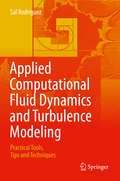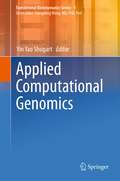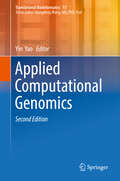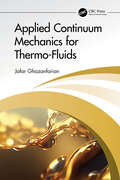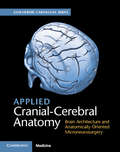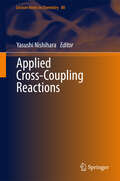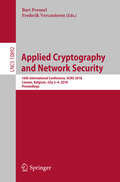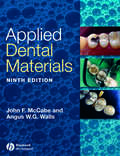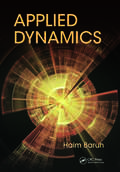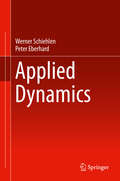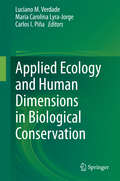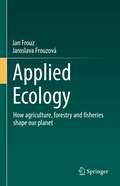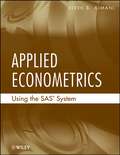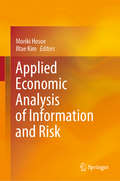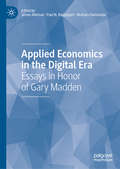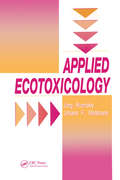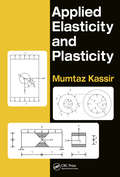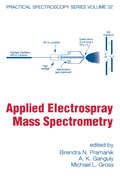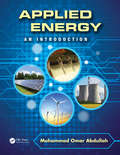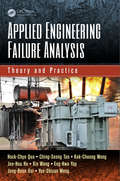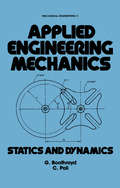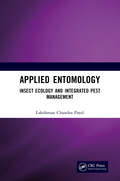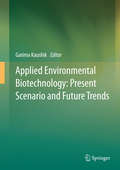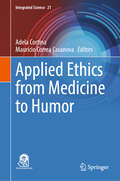- Table View
- List View
Applied Computational Fluid Dynamics and Turbulence Modeling: Practical Tools, Tips and Techniques
by Sal RodriguezThis unique text provides engineering students and practicing professionals with a comprehensive set of practical, hands-on guidelines and dozens of step-by-step examples for performing state-of-the-art, reliable computational fluid dynamics (CFD) and turbulence modeling. Key CFD and turbulence programs are included as well. The text first reviews basic CFD theory, and then details advanced applied theories for estimating turbulence, including new algorithms created by the author. The book gives practical advice on selecting appropriate turbulence models and presents best CFD practices for modeling and generating reliable simulations. The author gathered and developed the book’s hundreds of tips, tricks, and examples over three decades of research and development at three national laboratories and at the University of New Mexico—many in print for the first time in this book. The book also places a strong emphasis on recent CFD and turbulence advancements found in the literature over the past five to 10 years. Readers can apply the author’s advice and insights whether using commercial or national laboratory software such as ANSYS Fluent, STAR-CCM, COMSOL, Flownex, SimScale, OpenFOAM, Fuego, KIVA, BIGHORN, or their own computational tools. Applied Computational Fluid Dynamics and Turbulence Modeling is a practical, complementary companion for academic CFD textbooks and senior project courses in mechanical, civil, chemical, and nuclear engineering; senior undergraduate and graduate CFD and turbulence modeling courses; and for professionals developing commercial and research applications.
Applied Computational Genomics (Translational Bioinformatics #1)
by Yin Yao Shugart"Applied Computational Genomics" focuses on an in-depth review of statistical development and application in the area of human genomics including candidate gene mapping, linkage analysis, population-based, genome-wide association, exon sequencing and whole genome sequencing analysis. The authors are extremely experienced in the area of statistical genomics and will give a detailed introduction of the evolution in the field and critical evaluations of the advantages and disadvantages of the statistical models proposed. They will also share their views on a future shift toward translational biology. The book will be of value to human geneticists, medical doctors, health educators, policy makers, and graduate students majoring in biology, biostatistics, and bioinformatics. Dr. Yin Yao Shugart is investigator in the Intramural Research Program at the National Institute of Mental Health, Bethesda, Maryland USA.
Applied Computational Genomics (Translational Bioinformatics Ser. #1)
by Yin YaoThe volume provides a review of statistical development and application in the area of human genomics, including candidate gene mapping, linkage analysis, population-based genome-wide association, exon sequencing, and whole genome sequencing analysis. The authors are extremely experienced in the field of statistical genomics and will give a detailed introduction to the evolution of the field, as well as critical comments on the advantages and disadvantages of the proposed statistical models. The future directions of translational biology will also be described.
Applied Continuum Mechanics for Thermo-Fluids
by Jafar GhazanfarianApplied Continuum Mechanics for Thermo-Fluids presents the tensor notation rules and integral theorems before defining the preliminary concepts and applications of continuum mechanics. It bridges the gap between physical concepts and mathematical expressions with a rigorous mathematical treatment. After discussing fundamental concepts of continuum mechanics, the text explains basic subjects such as the Stokes hypothesis, the second coefficient of viscosity, non-Newtonian fluids, non-symmetric stress tensor, and the full Navier-Stokes equation. With coverage of interdisciplinary topics, the book highlights issues such as relativistic fluid mechanics, stochastic mechanics, fractional calculus, nanoscale fluid mechanics, polar fluids, electrodynamics, and traffic flows. It describes fundamental concepts of vorticity dynamics, including the definition of vorticity and circulation, with corresponding balance equations and related theorems.This text is intended for upper-level undergraduate and postgraduate mechanical, chemical, aerospace, civil engineering, and physics students taking continuum mechanics, advanced fluid mechanics, convective heat transfer, turbulence, or any other similar courses. In addition, this book can be an excellent resource for scientists who want to initiate research on topics related to thermo-fluids.Instructors will be able to utilize a Solutions Manual and Figure Slides for their courses. The eBook+ version includes the following enhancements: Videos placed throughout the text containing further explanation of key topics Multiple-choice quizzes to reinforce readers' understanding of physical concepts
Applied Cranial-Cerebral Anatomy: Brain Architecture and Anatomically Oriented Microneurosurgery
by Guilherme Carvalhal RibasThis book is the first to offer a comprehensive guide to understanding the brain's architecture from a topographical viewpoint. <P><P>Authored by a leading expert in surgical neuroanatomy, this practical text provides tri-dimensional understanding of the cerebral hemispheres, and the relationships between cerebral surfaces and the skull's outer surfaces through detailed brain dissections and actual clinical cases with operative photographs and correlative neuroimaging. For neurosurgeons, neuroradiologists and neurologists at all levels, this book emphasises the anatomy of the sulci and gyri of the cerebral surface. It is an essential resource for the general neurosurgery practice, and more particularly for planning surgical access routes for intracranial tumors. Authored by an international leading authority on macroscopic neuroanatomy, written from the author's extensive clinical experience. Heavily illustrated with operative photographs and correlative neuroimaging, for a detailed topographical understanding of intracranial neural structures. Focuses on resective surgery planning, for non-oncologic disease treatment
Applied Cross-Coupling Reactions (Lecture Notes in Chemistry #80)
by Yasushi Nishihara"Applied Cross-Coupling Reactions" provides students and teachers of advanced organic chemistry with an overview of the history, mechanisms and applications of cross-coupling reactions. Since the discovery of the transition-metal-catalyzed cross-coupling reactions in 1972, numerous synthetic uses and industrial applications have been developed. The mechanistic studies of the cross-coupling reactions have disclosed that three fundamental reactions: oxidative addition, transmetalation, and reductive elimination, are involved in a catalytic cycle. Cross-coupling reactions have allowed us to produce a variety of compounds for industrial purposes, such as natural products, pharmaceuticals, liquid crystals and conjugate polymers for use in electronic devices. Indeed, the Nobel Prize for Chemistry in 2010 was awarded for work on cross-coupling reactions. In this book, the recent trends in cross-coupling reactions are also introduced from the point of view of synthesis design and catalytic activities of transition-metal catalysts.
Applied Cryptography and Network Security: 16th International Conference, ACNS 2018, Leuven, Belgium, July 2-4, 2018, Proceedings (Lecture Notes in Computer Science #10892)
by Bart Preneel Frederik VercauterenThis book constitutes the refereed proceedings of the 16th International Conference on on Applied Cryptography and Network Security, ACNS 2018, held in Leuven, Belgium, in July 2018. The 36 revised full papers presented were carefully reviewed and selected from 173 submissions. The papers were organized in topical sections named: Cryptographic Protocols; Side Channel Attacks and Tamper Resistance; Digital Signatures; Privacy Preserving Computation; Multi-party Computation; Symmetric Key Primitives; Symmetric Key Primitives; Symmetric Key Cryptanalysis; Public Key Encryption; Authentication and Biometrics; Cloud and Peer-to-peer Security.
Applied Data Analysis and Modeling for Energy Engineers and Scientists
by T. Agami ReddyApplied Data Analysis and Modeling for Energy Engineers and Scientists fills an identified gap in engineering and science education and practice for both students and practitioners. It demonstrates how to apply concepts and methods learned in disparate courses such as mathematical modeling, probability,statistics, experimental design, regression, model building, optimization, risk analysis and decision-making to actual engineering processes and systems. The text provides a formal structure that offers a basic, broad and unified perspective,while imparting the knowledge, skills and confidence to work in data analysis and modeling. This volume uses numerous solved examples, published case studies from the author's own research, and well-conceived problems in order to enhance comprehension levels among readers and their understanding of the "processes"along with the tools.
Applied Dental Materials
by John F. Mccabe Angus WallsThis textbook covers all aspects of materials science relevant to the practice of dentistry. It is aimed primarily at undergraduate dental students, although it will also be useful for practising dentists, dental technicians and dental assistants.The 9th edition has been extensively revised to include the many advances in dental materials and their use that have occurred during the past nine years. The chapters on Resin-based filling materials and Adhesive restorative materials have been expanded significantly with new coverage of fibre reinforcement of composite structures and polymerisable luting agents. A brand new chapter has been added on endodontic materials.
Applied Dynamics
by Haim BaruhGain a Greater Understanding of How Key Components WorkUsing realistic examples from everyday life, including sports (motion of balls in air or during impact) and vehicle motions, Applied Dynamics emphasizes the applications of dynamics in engineering without sacrificing the fundamentals or rigor. The text provides a detailed analysis of the princi
Applied Dynamics (CISM International Centre for Mechanical Sciences #507)
by Werner Schiehlen Peter EberhardApplied Dynamics is an important branch of engineering mechanics widely applied to mechanical and automotive engineering, aerospace and biomechanics as well as control engineering and mechatronics. The computational methods presented are based on common fundamentals. For this purpose analytical mechanics turns out to be very useful where D'Alembert's principle in the Lagrangian formulation proves to be most efficient. The method of multibody systems, finite element systems and continuous systems are treated consistently. Thus, students get a much better understanding of dynamical phenomena, and engineers in design and development departments using computer codes may check the results more easily by choosing models of different complexity for vibration and stress analysis.
Applied Ecology and Human Dimensions in Biological Conservation
by Luciano M. Verdade Maria Carolina Lyra-Jorge Carlos I. PiñaThis book provides both the conceptual basis and technological tools that are necessary to identify and solve problems related to biodiversity governance. The authors discuss intriguing evolutionary questions, which involve the sometimes surprising adaptive capacity of certain organisms to dwell in altered and/or changing environments that apparently lost most of their structure and functionality. Space and time heterogeneities are considered in order to understand the patterns of distribution and abundance of species and the various processes that mold them. The book also discusses at which level--from genes to the landscape, including individuals, populations, communities, and ecosystems--men should intervene in nature in order to prevent the loss of biodiversity.
Applied Ecology: How agriculture, forestry and fisheries shape our planet
by Jan Frouz Jaroslava FrouzováThis book offers a comprehensive introduction to basic ecological and biological principles underlying modern agriculture, forestry, fisheries and aquaculture, and explains how these principles are used to increase the production of food and other raw materials (wood, biofuels, fibers and other materials). The book is translated into English, originally published in Czech by Karolinum Press, Charles University, and provides new updated information to discuss how the intensification of the production of these goods changes the structure of ecosystems concerning energy and nutrient flows, and how these changes affect the functioning of ecosystems and the subsequent provisions of other non-productive ecosystem services. Additionally, the authors describe the methods by which contemporary science and society strives to increase the sustainability of agriculture, forestry and fisheries to maintain not only the production of food and other goods, but also other ecosystem services. Although not a textbook on agriculture, forestry and fisheries, the book familiarizes readers with the principles of their technologies, because the impact on ecosystems is largely based on the technological processes used. The book is primarily focused on temperate ecosystems, but it contains a number of examples about marine and tropical ecosystems impacted by globalization and our consumer behavior. The book will be of interest to students and researchers with backgrounds in ecology and environmental science, as well as non-experts interested in ecology and environmental protection.
Applied Econometrics Using the SAS System
by Vivek AjmaniThe first cutting-edge guide to using the SAS® system for the analysis of econometric dataApplied Econometrics Using the SAS® System is the first book of its kind to treat the analysis of basic econometric data using SAS®, one of the most commonly used software tools among today's statisticians in business and industry. This book thoroughly examines econometric methods and discusses how data collected in economic studies can easily be analyzed using the SAS® system.In addition to addressing the computational aspects of econometric data analysis, the author provides a statistical foundation by introducing the underlying theory behind each method before delving into the related SAS® routines. The book begins with a basic introduction to econometrics and the relationship between classical regression analysis models and econometric models. Subsequent chapters balance essential concepts with SAS® tools and cover key topics such as:Regression analysis using Proc IML and Proc RegHypothesis testingInstrumental variables analysis, with a discussion of measurement errors, the assumptions incorporated into the analysis, and specification tests Heteroscedasticity, including GLS and FGLS estimation, group-wise heteroscedasticity, and GARCH modelsPanel data analysisDiscrete choice models, along with coverage of binary choice models and Poisson regressionDuration analysis modelsAssuming only a working knowledge of SAS®, this book is a one-stop reference for using the software to analyze econometric data. Additional features include complete SAS® code, Proc IML routines plus a tutorial on Proc IML, and an appendix with additional programs and data sets. Applied Econometrics Using the SAS® System serves as a relevant and valuable reference for practitioners in the fields of business, economics, and finance. In addition, most students of econometrics are taught using GAUSS and STATA, yet SAS® is the standard in the working world; therefore, this book is an ideal supplement for upper-undergraduate and graduate courses in statistics, economics, and other social sciences since it prepares readers for real-world careers.
Applied Economic Analysis of Information and Risk
by Moriki Hosoe Iltae KimThis book examines interesting new topics in applied economics from the perspectives of the economics of information and risk, two fields of economics that address the consequences of asymmetric information, environmental risk and uncertainty for the nature and efficiency of interactions between individuals and organizations. In the economics of information, the essential task is to examine the condition of asymmetric information under which the information gap is exploited. For the economics of risk, it is important to investigate types of behavior including risk aversion, risk sharing, and risk prevention, and to reexamine the classical expected utility approach and the relationships among several types of the changes in risk. Few books have ever analyzed topics in applied economics with regard to information and risk. This book provides a comprehensive collection of applied analyses, while also revisiting certain basic concepts in the economics of information and risk. The book consists of two parts. In Part I, several aspects of applied economics are investigated, including public policy, labor economics, and political economics, from the standpoint of the economics of (asymmetric) information. First, several basic frameworks of the incentive mechanism with regard to transaction-specific investment are assessed, then various tools for market design and organization design are explored. In Part II, mathematical measures of risk and risk aversion are examined in more detail, and readers are introduced to stochastic selection rules governing choice behavior under uncertainty. Several types of change in the random variable for the cumulative distribution function (CDF) and probability distribution function (PDF) are discussed. In closing, the part investigates the comparative static results of these changes in CDF or PDF on the general decision model, incorporating uncertain situations in applied economics.
Applied Economics in the Digital Era: Essays in Honor of Gary Madden
by James Alleman Paul N. Rappoport Mohsen HamoudiaGary Madden was a renaissance man with respect to the nexus between information and communications technology (ICT) and economics. He contributed to a variety of fields in ICT: applied econometrics, forecasting, internet governance and policy. This series of essays, two of which were co-authored by Professor Madden prior to his untimely death, cover the range of his research interests. While the essays focus on a number of ICT issues, they are on the frontier of research in the sector. Gerard Faulhaber provides a broad overview of how we have reached the digital age and its implications. The applied econometric section brings the latest research in the area, for example Lester Taylor illustrates how own-price, cross-price and income elasticities can be calculated from survey data and translated into real income effects. The forecasting section ranges from forecasting online political participation to broadband’s impact on economic growth. The final section covers aspects of governance and regulation of the ICT sector.
Applied Ecotoxicology
by Johann F. Moltmann D.M. RawsonThis new book illustrates the complex nature of ecotoxicological issues, using pesticides as an example. It focuses on the assessment and monitoring of the amounts of pollutants in the environment and the subsequent damage. The text provides the basic information and methodology to help the reader determine the extent of ecological damage caused by a given substance.Legislatures in industrialized countries have taken the initiative in dealing with these issues by formulating new priorities for environmental protection. Applied Ecotoxicology describes these regulatory efforts, which are separated by their two distinct objectives: those that seek to expand the scope of protection against the pollutants' negative impacts, and those shifting the level of investigation from the individual to the ecosystem.Pollutants are only one of a number of different environmental factors to which organisms are exposed. Their impact in the field is presented in the context of other forms of human intervention in the environment. The increasing use of pesticides in tropical regions, a growing ecotoxicological concern in these countries, is also discussed.
Applied Elasticity and Plasticity
by Mumtaz KassirApplied Elasticity and Plasticity is a comprehensive work that introduces graduate students and professionals in civil, mechanical, aeronautical and metallurgical engineering to the basic theories of elasticity, plasticity and their practical applications. Based on experimental data of static tension tests of material, several elastic and plastic stress-strain relations are derived, and commonly-used yield criteria and strain hardening rules are discussed as well. Analysis of conventional, deviatoric and mathematical stress and strain in two and three dimensions is presented. Analytical applications include torsion and bending of structural components subjected to various loadings, thick-walled cylindrical and spherical vessels subjected to internal and external pressures, stress-concentrations around holes, stress-intensity factors in structural components containing circular, elliptical and many more concepts important for professionals and students alike.
Applied Electrospray Mass Spectrometry: Practical Spectroscopy Series Volume 32 (Practical Spectroscopy Ser. #Vol. 32)
by Michael L. Gross Birendra N. Pramanik A. K. GangulyDiscussing strategies to determine the structure and machanisms of numerous compound classics, this book covers new chemical and elctrophoretic techniques for rapid sample preconcentration and separation. It summarizes breakthroughs in the theory and instrumentation of electrospray mass spectrometry in pharmaceutical and biomedical applications, pr
Applied Energy: An Introduction
by Mohammad Omar AbdullahWritten in clear, concise language and designed for an introductory applied energy course, Applied Energy: An Introduction discusses energy applications in small-medium enterprises, solar energy, hydro and wind energy, nuclear energy, hybrid energy, and energy sustainability issues. Focusing on renewable energy technologies, energy conversion, and
Applied Engineering Failure Analysis: Theory and Practice
by Xin Wang Hock-Chye Qua Ching-Seong Tan Kok-Cheong Wong Jee-Hou Ho Eng-Hwa Yap Jong-Boon Ooi Yee-Shiuan WongThis book fills the gap between failure analysis theory and the actual conducts of the failure cases. The book demonstrates the main methodologies that have evolved over time and includes examples from the 1970s to date. Engineering calculations and estimation of system stresses and strengths are given in the relevant chapters. It presents a wide range of cases studies, ranging from mechanical engineering, metallurgy, mining, civil/structural engineering, electrical power systems, and radiation damage.
Applied Engineering Mechanics: Statics and Dynamics (Mechanical Engineering #5)
by G. Boothroyd C. PoliThis is the more practical approach to engineering mechanics that deals mainly withtwo-dimensional problems, since these comprise the great majority of engineering situationsand are the necessary foundation for good design practice. The format developedfor this textbook, moreover, has been devised to benefit from contemporary ideas ofproblem solving as an educational tool. In both areas dealing with statics and dynamics,theory is held apart from applications, so that practical engineering problems, whichmake use of basic theories in various combinations, can be used to reinforce theoryand demonstrate the workings of static and dynamic engineering situations.In essence a traditional approach, this book makes use of two-dimensional engineeringdrawings rather than pictorial representations. Word problems are included in the latterchapters to encourage the student's ability to use verbal and graphic skills interchangeably.SI units are employed throughout the text.This concise and economical presentation of engineering mechanics has been classroomtested and should prove to be a lively and challenging basic textbook for two onesemestercourses for students in mechanical and civil engineering. Applied EngineeringMechanics: Statics and Dynamics is equally suitable for students in the second or thirdyear of four-year engineering technology programs.
Applied Entomology: Insect Ecology and Integrated Pest Management
by Lakshman Chandra PatelThe subject of Entomology deals with the scientific study of insects in a diverse manner. It has two parts: - Insect Morphology, Anatomy and Systematic - Insect Ecology and Integrated Pest Management (IPM). This book applies to students, researchers, extension workers, farmers and other stakeholders. Both classroom and field learning are important with this updated information to enhance need-based knowledge and skill. Applied Entomology: Insect Ecology and Integrated Pest Management covers mostly used practical work at the field level apropos Insect Ecology and Integrated Pest Management (IPM). Print edition not for sale in India.
Applied Environmental Biotechnology: Present Scenario And Future Trends
by Garima KaushikApplied Environmental Biotechnology: Present Scenario and Future Trends is designed to serve as a reference book for students and researchers working in the area of applied environmental science. It presents various applications of environmental studies that involve the use of living organisms, bioprocesses engineering technology, and other fields in solving environmental problems like waste and waste waters. It includes not only the pure biological sciences such as genetics, microbiology, biochemistry and chemistry but also from outside the sphere of biology such as chemical engineering, bioprocess engineering, information technology, and biophysics. Starting with the fundamentals of bioremediation, the book introduces various environmental applications such as bioremediation, phytoremediation, microbial diversity in conservation and exploration, in-silico approach to study the regulatory mechanisms and pathways of industrially important microorganisms biological phosphorous removal, ameliorative approaches for management of chromium phytotoxicity, sustainable production of biofuels from microalgae using a biorefinery approach, bioelectrochemical systems (BES) for microbial electroremediation and oil spill remediation. The book has been designed to serve as comprehensive environmental biotechnology textbooks as well as wide-ranging reference books. Environmental remediation, pollution control, detection and monitoring are evaluated considering the achievement as well as the perspectives in the development of environmental biotechnology. Various relevant articles are chosen up to illustrate the main areas of environmental biotechnology: industrial waste water treatment, soil treatment, oil remediation, phytoremediation, microbial electro remediation and development of biofuels dealing with microbial and process engineering aspects. The distinct role of environmental biotechnology in future is emphasized considering the opportunities to contribute with new approached and directions in remediation of contaminated environment, minimising waste releases and development pollution prevention alternatives at before and end of pipe.
Applied Ethics from Medicine to Humor (Integrated Science #21)
by Adela Cortina Mauricio Correa CasanovaApplied ethics is an essential part of practical knowledge in pluralistic and democratic societies. Its fundamental characteristic does not consist only in reflecting on the new moral realities of modern life, but also in guiding the deliberation and freedom of moral agents, people and institutions. This book comprises works on applied ethics by specialists from Spain and Chile. Some topics are well known for their extensive development and dissemination, such as biomedicine, country development, ecology, economics, enterprise and business, and professions. Others themes are presented with the novelty of current debates, such as neuroethics, sports, humor and the city. This book offers a broad look at each topic, and simultaneously provides a moral compass that ethically guides professors and researchers, students and professionals, in order to empower their activities and institutions.
